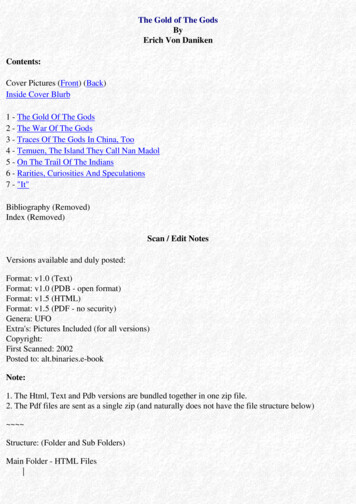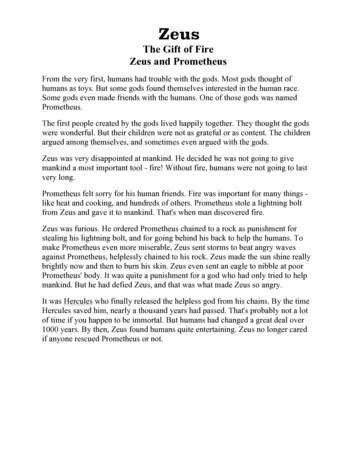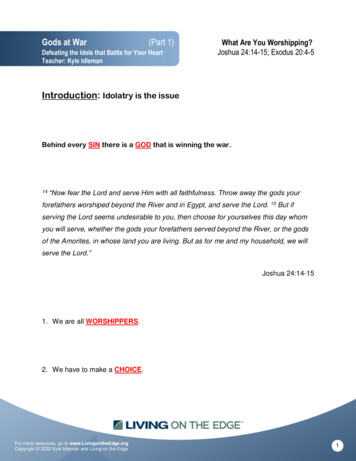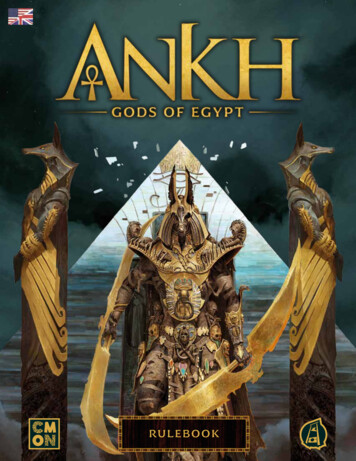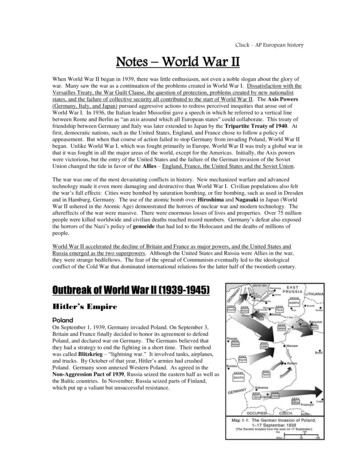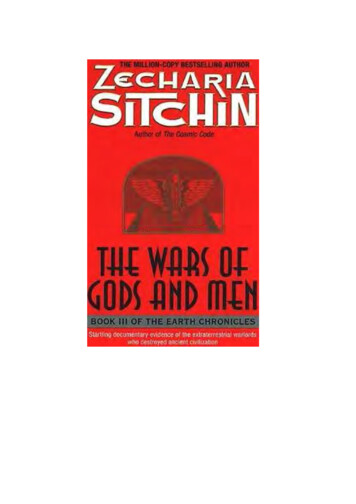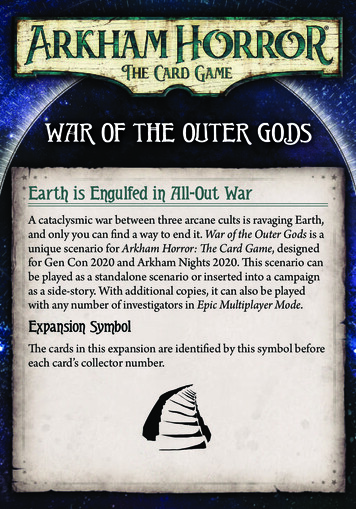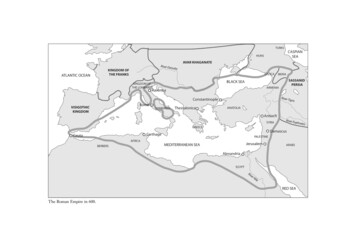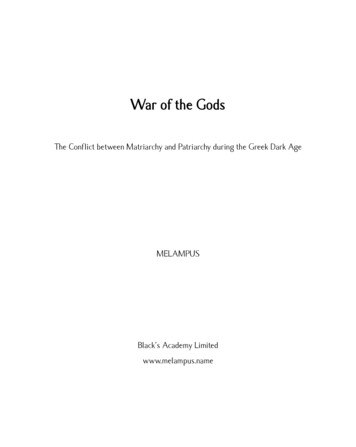
Transcription
War of the GodsThe Conflict between Matriarchy and Patriarchy during the Greek Dark AgeMELAMPUSBlack’s Academy Limitedwww.melampus.name
DedicationTo the Mother of MelampusBlack’s Academy LimitedKington, England Black’s Academy Limited 2019Electronic version for pdf distribution.
ContentsGod or Goddess?Darkness VisibleThe CatastropheThe Minoan-Mycenaean CultureHuman Sacrifice and its DenialMethodology of Reading MythThe History of Greek Religion in the Dark AgeThe Reformation of Greek ReligionPatriarchy Full Steam AheadConclusion1247223540637378
God or Goddess?Religion encourages some behaviours and prohibits others. It legislates, amongother things, on sexual relations. The Christian religion is historically associatedwith patriarchy: it calls upon “God the Father”, and even if it names Mary the“Mother of God” and Sophia his Bride, it has an all-male Trinity; it has preachedsexual continence; it has advocated the duty of the father to bring up daughters asvirgins and to remain chaste in marriage, assuring the paternity of sons and descent through the male-line. The history of Greek religion demonstrates that thisideology did not always obtain. Until very late in the historical record, men andwomen danced naked together at religious festivals that were devoted to fertility.Greek myth speaks of terrestrial-born gods and heroes who did not know theirearthly fathers—the sons of gods, begat upon goddesses, priestesses or nymphs,such as Dionysus begotten by Zeus on Semele, the daughter of King Cadmus ofThebes, or Perseus, whose father, Zeus, fornicated with his mother Danae “in agolden shower”. There was a time when fornication was sacred.The earliest cultures of Greece, the Cycladic and Minoan, depict only theGoddess, and where man appears in the context of divinity, he does so solely asHer dependant consort. We see only Her priestesses officiating at sacrifice.Women were important politically, socially and economically in ways that cameto be unimaginable in later patriarchal epochs. They participated in the chase andfought as “Amazons” in wars. They were not the tame and mutely domesticatedcharacters that they came to be, if not in reality, at least in representation. Imagery announces this truth—at first, we see women enthroned or officiating at sacrifice; by classical times (after 479), we see them depicted at home, weaving, orwishing farewell to men as they depart to battle. From woman triumphant towoman domesticated and humble there was a journey.We look at Greek history through the later constructions of the Greeks themselves. The Greeks had lost the power of writing during their Dark Age(c.1200—c.750). By the time they came to write history, Greek historians, men,made the backward projection of patriarchy. The myth that male domination hassome eternal source has been perpetuated by patriarchy ever since. There is amodern bias too: the contemporary bias of historians working from archaeologicalevidence to overlook Greek and Roman written sources that originate in an oraltradition stretching back into the darkness itself.During the Greek Dark (c.1200—c.750) and Archaic (c.750—479) ages therewas a violent, bloody and protracted conflict between matriarchy and patriarchyas a result of which matriarchy was overthrown.Figure 1. The GoddessMarble statue from AmorgasEarly Cycladic II2800—2300
Darkness VisibleThe transition from matriarchy to patriarchy was not the only transformation that took place in the darkness.There was an alteration in the very way in which people think: a change from primitive materialism to Ionianconsciousness. There was the abandonment of the practice of human sacrifice.Ionian consciousness is the cognitive structure of our own contemporary academic culture, and we are indebted to the Ionian Greeks for it. When Thales of Miletus (c.624—c.546) wrote, “All things are from water and allthings are resolved into water,” a new understanding of the world had its inception. Miletus is in Ionia, so I callthis way of thinking “Ionian consciousness”. In his statement Thales was the first person we know of to make adistinction between appearance and reality, between what subjectively appears to us in perception and what objectively appertains in the “real” and “external world”. It is this distinction that lays the basis for modern naturalscience, for it conceives of the world as existing independently of the conscious mind that perceives it—a worldthat may “run” mechanically according to unchanging laws of nature that operate on events in objective time.Mind and matter are thus separated in Ionian consciousness. Ionian consciousness also introduces for the firsttime the concept of infinity. These two ideas—objective reality and infinity—make mathematics as we know itpossible, and the appearance of geometry and number theory follow hard upon the heels of the Ionian revolution,as does the atomic theory of Democritus, another Ionian thinker.The system of Olympian religion such as we find in Homer is of a pantheon of major gods dominated by apowerful king-god Zeus; there are also myriads of other deities or older powers, such as Rhea, Mother of theGods, and her offspring, the Titans. All these deities indulge in behaviours that are very human-like—the malegods rape women, and all of them have love affairs, commit adultery, fight bloody wars, get wounded in battle andexperience the gamut of human emotions: love, anger,jealousy, envy. In Ionian consciousness, all of this becomes morally unjustifiable. A single famous quotationfrom the work of an Ionian thinker, Xenophanes of Colophon (c.570—c.475), sums up the whole devastating critique: “Homer and Hesiod attributed to the gods all thethings which among men are shameful and blameworthy—theft and adultery and mutual deception.” Wherethere is only large and larger, there is no contradiction inthe notion of a plurality of gods, but where there is infinity, only one god may occupy the supreme position, and“He” must be above all human passions. Monotheism isborn, and patriarchy rationalised.Ironically, Thales also expresses the dominant idea ofFigure 2. Naked DancersTomb of Kamilari, near Phaistos, c.1500.the earlier stage of cognition, primitive materialism, whenThe religious context is indicated by the horns of consecrahe writes, “Everything is full of gods.” Thales introducedtion.
3the new Ionian form of consciousness, but this emerged from the older one. In Primitive materialism there is nodistinction between appearance (perception) and reality, and there is no concept of infinity. There is a tendencyto think of time as cyclical, of events as a repetition of an eternal oscillation, like day following night, and nightfollowing day. Ancient Egyptians thought of their king as Horus while alive, and as Osiris once dead, notwithstanding the contradiction that Osiris is the father of Horus and both are married to their sister-mother, Isis; allPharaohs are different, all yet one and the same.The science of primitive materialism is magic. Everything is full of gods, but some things are fuller of godsthan others; hence, there are sacred places and sacred objects where the gods are particularly present. The wholescience of magic is laid bare in the sacred texts of the Egyptians, in the Book of the Dead. Or, for example, consider this extract from the Memphite Theology of Creation, a document originating from c.2500: “ [Ptah] is inevery mouth of all gods, all men, [all] cattle, all creeping things, and (everything) that lives ” This asserts thatthere is a single divine presence that is found in lesser or greater degree in all things—all things are living. Thissystem of spiritual presence is also law-like, so that man as magus can control nature—he does so through therites of invocation, through ritual sacrifice, and, when writing is present, through inscriptions. The word haspower to transform nature. To the ancient there is one-world of fused matter and spirit, of god manifest in allthings, without distinction between animate and inanimate; we could also call this “material vitalism”. TheEgyptian magus believed that a statue made of clay could, by operation of the magic formulas inscribed upon thetomb walls, come alive within the tomb. Man is clay made animate by the divine spirit, which is also a breath, aphysical thing.Primitive materialism is also a system of primitive dualism in which the “soul” is a detachable physical partof the body—a breath primarily. In primitive materialism, there is no death of the soul. When a warrior is slainin battle, the spirit departs the body and goes somewhere else—it may inhabit the tomb, descend to the underworld, depart to a blessed isle, or ascend to the halls of the ancestors. The primitive had limited fear of death,because he did not conceptualise it as we do. Ionian cognition first made it possible to conceive of death as theutter annihilation of the person; it also made possible the idea that at death body and soul separate: the body tobreak apart in physical corruption to re-join inorganic material, and the soul to depart to the afterlife—be itHades, Hell, the Isle of the Blessed, or Heaven.We fail to take into our accounts the observation that ancient men and women did not think in the same waywe do. Nowadays, no general would delay the fighting of a battle (or at least would admit to delaying one) because the sacrificial victim’s liver was found to be the wrong-way round. But in the ancient world, this wasstandard practice. We cannot understand their polity without taking this difference of cognition into account.Furthermore, the transition from primitive materialism to Ionian consciousness was not a once-and-for-all breakwith the past: as if, once Thales had spoken, all were immediately enlightened. We can only understand Greekhistory against the background of a slow developmental change in cognition, where even at the time of Socratesand Plato, the bulk of humanity still conceived of the world through the earlier concepts. During the bitter Peloponnesian War fought between Athens and Sparta (431—404), consultation with oracles was an essential preliminary to any action, and, under pressure of war and plague, many atrocities and atavisms were committed—theseare the expression of older solutions to problems presenting themselves during times of great stress, for the mainsolution to any practical problem within primitive materialism is sacrifice.
The CatastropheOur story begins in the late Bronze Age, c.2200—1900 with the arrival from the north of the “Hellenes” on theGreek mainland, an event identified by a discontinuity in material culture, indicated by the differences betweenEarly Helladic II and Early Helladic III pottery. These migrants spoke an early form of Greek, an Indo-Europeanlanguage. The language of the original inhabitants is not known for certain. The Greeks had various names forthese “aboriginals”—Pelasgians, Leleges and Carians—by which they acknowledged that their race and culturewas a fusion of more than one peoples. During the ensuing epoch the Minoan culture, issuing from Cretan palaces such as Knossos, Phaistos and Malia, came to dominate the Greek and Aegean world. From 1600 onwards,we can talk of a distinctive “Achaean” Greek culture on the mainland known as the Mycenaean. Both the Mycenaeans and the Minoans were highly organised societies conducting extensive international trade with all parts ofthe known world, from Spain (silver) and Britain (tin) in the west to Egypt and Mesopotamia in the East, fromthe Baltic region (amber) to the north, to Libya and Ethiopia (ivory) to the south; their industry and trade werecentrally administered from large palace complexes. But in the early Minoan “neo-palatial” period (c.1600—c.1380) Crete was politically dominant and mainland Greece trod after her; while in the later Minoan “postpalatial” period (c.1380—c.1200) Mycenae took the lead. It is thought that a series of natural disasters thatstruck Crete—the volcanic eruption of the island of Thera (an event of colossal force dated variously betweenc.1650 and c.1500), and earthquakes (c.1450 and possibly c.1380), weakened the Minoan economy and gave theMycenaeans the edge. By c.1380 Knossos was occupied by Greek speaking overlords, and the non-Greek of theMinoan Linear A writing was replaced by the Greek of Linear B as the language of palace administration.Then c.1200 a catastrophe or series of catastrophes occurred that affected the entire civilised world of theNear East; this is known collectively as the Bronze Age Collapse. In mainland Greece and in Crete the principalknown palace centres were destroyed—Mycenae, Tiryns, Midea, Pylos, Thebes, Orchomenos, the Menelaion(“Sparta”), Knossos and Cydonia. (Athens is thought to have survived, though damaged.) The Hittite empirecollapsed and disappeared. Troy was destroyed. In Syria and Upper Mesopotamia all the major cities were destroyed, including Ugarit, Aleppo and Carchemish. Destruction was also wrought upon the cities of the Levant,including Megiddo, Ashdod, Bethel and Lachish. Likewise, the major cities of Cyprus were destroyed: Enkomi,Kastro, Sinda and Kition. Egypt came under severe attack from invaders known as the “Sea Peoples”, andthough it repulsed them on more than one occasion, the invasions marked the end of ancient Egyptian power andprosperity. It may surprise the reader to learn that taken overall, this catastrophe constitutes the single greatestdisaster to have befallen the Western civilised world. During the Bronze Age Collapse it is likely that the population of the Near East decreased by as much as 90%.Following the Bronze Age Collapse Greece entered a Dark Age, (c.1200—c.750), after which the Greeksonce again learned to write. Then, from c.750 down to the Persian Wars, when Xerxes lead a huge force intoGreece and was defeated at sea at the Battle of Salamis (480) and on land at the Battle of Platea (479), we havethe archaic period. These, then, form the principal epochs of our study: (I) Before c.2100: Middle Bronze Age(“Pelasgians”); (II) c.2100—c.1600: Late Bronze Age (“Hellenes”); (III) c.1600—c.1380: Minoan phase(“Achaeans”); (IV) c.1380—c.1200: Mycenaean hegemony (“Mycenaeans"); (V) c.1200—c.750: Dark Age; (VI)
5c.750—479: Archaic period; (VII) 479 onwards: Classical and subsequent periods. Between the Mycenaeanperiod and the Dark Age, lying on its boundary, occurs the catastrophe of the Bronze Age Collapse.“Boundary” events may be associated with the other transitions: between the Minoan and Mycenaean periodsthere was a possible earthquake at Knossos and a “capture” of that palace by Greek-speaking “overlords”; between the Greek Dark Age and the Archaic period there was the inception of the Olympic Games in 776. Discontinuities in material culture that are marked by changes in pottery styles, architecture and the other plastic artsmay be associated with these significant boundary events. They belong to the centre and pattern of the disturbances, and so help to explain them. Most significant of all was the seismic disturbance of the Bronze Age Collapse; it stands at the centre of explanation of the three great transformations that I have already indicated.Explanations of the Bronze Age Collapse: (A) those dealing with events located on the boundary, such as theattempted invasion of Egypt by the “Sea Peoples”, which are “triggers” or “immediate consequences”; (B) thosedealing with long-term causes, such as crop failure, climate change, and changes in methods of warfare; (C) thosedealing with the system response to a crisis, that emphasise the vulnerability of the system prior to the crisis, andits failure following it. It seems likely that all three types of explanation are involved, but here the system response is taken as decisive. Whatever events may have triggered the destruction of this or that palace, no suchtrigger will account for the wholescale destruction of civilisation, or for the fact that the population did not quickly recover. The routine response of any culture to a disaster is to rebuild, so the central problem that we mustaddress is why such rebuilding did not take place, why, in the case of Greece, a Dark Age lasting four or fivehundred years followed. There is nothing comparable in all human history to the Bronze Age Collapse.Prior to the Bronze Age Collapse, Greek society held to a matriarchal religion in the context of a cognitivestructure denoted here by primitive materialism and practiced human sacrifice. At some time after the catastrophe Greek culture adopted a patriarchal religion, the cultural elite changed their cognition to Ionian consciousness, and Greeks gave up in principle the practice of human sacrifice.Among the explanations of the category of triggers there is the explanation that the Greek historians themselves developed and elaborated—the theory of a Dorian invasion of the Peloponnese. We are now in the position to demonstrate that this theory is false. One criticism against this thesis is that there is no evidence for it inthe archaeological record. However, it is the internal inconsistencies of the account that tell most decisivelyagainst it. The palaces were destroyed on or around 1200, a fact not known to Greek historians, so an invasionpostulated to have taken place in 1104 cannot explain the Bronze Age Collapse.There are other practical inconsistencies. Anyone who has visited Greece will realise that it is a mountainouscountry that favours defence over attack, and makes travel by foot, whether there are roads or not, very difficult.The distance between two points may be measured “as the crow flies”, but a more practical measure could be“the time it takes to walk it”. A topological map of walking distances of Mycenaean Greece needs to be made.Reports indicate that the Mycenaeans had some road network, but not such as would have made the marching ofinvasion armies into an everyday occurrence. Roads in mountainous countries are easily defended by posterns.When Thucydides wrote, “Mycenae was certainly a small place, and many of the towns of that period do notseem to us today to be particularly imposing,” (Peloponnesian War,1.40) he cannot have visited the cyclopeanruins of that citadel’s walls, or have seen Gla, or realised that ancient Thebes occupied a ground twice the size ofMycenae. This is important: what Thucydides says about prehistoric Greece is a description of its Dark Age—he
6does not know of the Mycenaean palace culture any more than Homer did. The idea of large invasion forcesseems out of place with what the geography and topology of Greece suggests. We should speak of slow migrations and fusions of peoples, rather than of conquests. The impression that Mycenaean Greece was a warriorsociety is, of course, affirmed by the legends, which speak of two wars of monumental proportions—a doubleconflict between Argos and Thebes, and the expedition against Troy. Yet Argos scarcely existed as a centre ofimportance in the Mycenaean age; it is true that Thebes was destroyed, and possibly twice, and there is just theshadow of a chronology suggested by the archaeological record that we can date its second destruction to justbefore 1200, the time of the ‘Epigonae’ (Seven Against Thebes) of Greek legend; that would make Thebes thefirst of the palaces to be destroyed, just before the boundary period of the Bronze Age Collapse onto which wemust place the Trojan War, if it ever took place. (The dating is by pottery styles and concerns the differencesbetween pottery of the Late Helladic III B2 style and the Late Helladic early III C style. This boundary occurs onor around 1190.) Invasion of the Peloponnese by a Dorian horde crossing the Corinthian Gulf and then traversing a mountainous land route is highly unlikely. Perhaps a sea-borne invasion is possible.This connects to the “Sea-Peoples” theory. In this theory the cities of Asia Minor and the Greek palaces weredestroyed by sea-borne invaders. The evidence for Sea-Peoples comes from Egyptian inscriptions that point toinvasions of the Delta in the third year of Merneptah, 1207, and to invasions in the fifth, eighth and twelfth yearsof the reign of Rameses III. Of these latter, the invasion in the eighth year is taken to be the most significant, andthis is currently dated to 1177. Additionally, letters discovered at Ugarit in Syria date its destruction to between1190 and 1185 specifically by sea-borne forces.None of this serves to account for the Bronze Age Collapse and why that collapse lasted so long. A city orpalace may be destroyed, but the people flee to the surrounding lands, return and rebuild. The Sea Peoples themselves would appear to be Achaean Greeks predominantly. Among the Sea Peoples the Peleset are identifiedwith the Philistines, who are thought to be Greeks, and are often connected with Cretans. The forces mounted bythe Sea Peoples do not appear to be very large, even in the Egyptian records, where details and numbers may beinflated by pride. The force attacking Ugarit in the letters is said to comprise no more than seven ships, not morethan 1000 men, and if this force did overwhelm that city it is because the king’s forces were away defending theHittite Empire, just as King Ammurapi states in his letter to Cyprus. So, it seems we need to postulate anotherSea Peoples to attack and destroy both Mycenaean Greece and the Hittite Empire, looking upon the Sea Peoplementioned in the Egyptian texts and elsewhere as a secondary force of displaced people arising from the first.There is no historical evidence at all for this first Sea Peoples, though some historians have simply postulated aninvasion from Central Europe, or from Sardinia or Sicily to provide a supply of missing men.The logistics of war must also subvert this theory decisively. A sea-borne force might invade and overwhelmPylos, but could their numbers be so great as to mount successive invasions of Mycenae and its port Tiryns, bothextensively fortified, and then go on to devastate a whole land for more than four hundred years? At best, wehave here glimpses of the triggers, but the underlying causes are not revealed. Thus, on the contrary, when theinvasion hypothesis collapses because it is wholly empty of explanatory force, we must revert to the hypothesisof internal conflict. Among all the causes of terrible destruction, civil wars are the worse in their effects, andthere is one kind of civil war that is known to bring about terrible loss of life and unprecedented cruelty, and thisis a war of religion—witness the Crusades, the Thirty Years War, and the French Wars of Religion.
The Minoan-Mycenaean CultureDescent through the female line I denote by the term matrilineal. Female rule to the exclusion of male participation I denote by gynarchy. Predominance of female power socially and politically, I denote generically by matriarchy. A theology that claims that the world is the manifestation of a female power, I denote by Gaiaism. Greekand Roman letters speak of societies that were gynarchies—of Amazons, of the women of Lesbos—but a societyin which men have no rights at all is scarcely something we can imagine when dealing with ancient civilisations;one finds a structure in which both men and women have social power, but in which women are dominant, orconversely, where the rights of men are inferior to those of women. Such a mixed structure is also a matriarchy.Since the extent of female power can range from pure gynarchy down to equality, the notion of a developed matriarchy is pertinent: a social structure originating in some purer form of matriarchy that has been successivelydiluted; men have prominent roles, but society remains theologically founded upon female power, and womenclass-by-class have greater rights. The Etruscan civilisation was a developed matriarchy, as demonstrated in theirfunerary arrangements—women had larger and more elaborate tombs than men. Ancient Egypt was also a developed matriarchy. The thesis is that Mycenaean Greece was a developed matriarchy, while the earlier MinoanCrete was a matriarchy proper, and if not a gynarchy, closer to it. The grades of matriarchy progress from gynarchy, to matriarchy to developed matriarchy—they are all matriarchies, but some are more matriarchal than others.Men have long entertained the notion that women are the “weaker sex” in ways that make them unfit forfighting or for confronting morally challenging situations, more adapted to domesticity under the “protection” oftheir fathers, husbands and even sons; but these norms are likely to prove to be socially constructed.The Linear B tablets make it clear that men of the Mycenaean world did have prominent roles, some identified by titles such as wanax, guasileus, lawagetas, telestas and hequetas, which have been translated as ‘king’,‘country lord’, ‘leader of the people’, ‘court official’, and ‘knight companion’ respectively. The kingdom of Pylos was also divided into sixteen regions each administered by a ko-re-te, who had a deputy, a po-ro-ko-re-te.These officials also appear to be men. Occupations are also strongly typed by gender. At Pylos, female occupations include: corn-grinding, nursing, carding, spinning, flax-working, bath-attendance and waiting.Has all our “understanding” of the Mycenaean and Minoan cultures been contaminated by the backward projection of patriarchy? Is there any evidence to prove that the Mycenaeans lived in families, or is there merely anassumption that they must have lived thus with a male head of the house, because that is the way we have lived?I can find no evidence in the Linear B tablets for what we call family life. Men and women appear to be segregated into work-groups and young boys and girls stay with their mother. The following is a typical entry.(Aa01)me-re-ti-ri-ja WOMAN 7 ko-wa 10 ko-wo 6Seven corn-grinding women, ten girls, six boys.The expression “WOMAN” indicates an ideogram rather than a word. The translation is by Ventris and Chadwick. The work of these two great scholars is coloured by the backward-projection of patriarchy; nonetheless,they observe: “The casual references to the fathers of the children [in one tablet referring to “rowers”] also seem
8to indicate that they are not the product of any regular union. The absence of men listed in their own right is surprising; women appear to predominate, and where the men are listed it is as the sons of the women.” (Documentsin Mycenaean Greek, p.156.) Furthermore, boys of a certain age are taken from their mothers and trained separately.(Ad676)pu-ro re-wo-to-ro-ko-wo ko-wo MEN 22 ko-wo 11At Pylos: twenty-two sons of the bath-attendants, eleven boys.There appears to be no separate word in Mycenaean Greek for “wife”, and no unambiguous mention of a “wife”at all; no mention of preparations for a wedding or marriage. Priests and priestesses arrange sacrifices; they donot arrange marriages, so far as we know. While we conclude that most children did not know who their fatherwas, there is evidence of concern for paternity within the ruling class.(Sn01.15)ne-qe-u e-te-wo-ke-re-we-i-jo to-towe-to o-a-ke-re-se ZE I [X nn]Ne-qe-u son of Etewoklewes this year took as follows: one pair, x X.(The denotation of x X, is not known.) The presence of a patronymic is rare and does not prove that Neqeu wasthe biological son of Etewoklewes; he may have been adopted. Greek mythology speaks of countless occasionswhen a hero who did not know his father was adopted by another man: for example, Heracles was adopted byAmphitryon and Theseus by Aegeus, and perhaps not so well-known but pertinent, Ephialtes and Otus, sons ofIphimedeia by Poseidon, were adopted by Aloeus. But the fact that some of the men at Pylos are known as sonsof other men is significant. The picture emerges of a developing masculinism out of a background of matriarchy.Let us elaborate a little on what is missing from the Linear B tablets. We know what the people ate—mainlybread and figs—but we don’t know where they ate; we don’t know who they ate with; from the evidence presented it seems unlikely that they lived in families; while there were houses of “apsidal” design, we do not know exactly where men and women of the segregated work-groups slept; some tablets indicate that workers were assigned bedding in pairs, but the pairings are for two men, a man and his daughter, and for a woman and herdaughter; hence, we do not know whether they slept alone, in groups, and if in groups, whether these were samesex groups; we suspect that the “aristocracy” washed in baths because there are bath-attendants, but we don’tknow what the common-people did for sanitation; the records do not appear to say anything about washing andlaundry; the tablets say nothing about how men and women met for the sake of procreation; we know nothingabout their entertainments; some preparations for a religious festival or service are indicated, but we know only alittle of their festive calendar; we do not know how these festivals were celebrated; there is no reference to howthe wanax or his officials were appointed; there are sons, but no knowledge of laws of inheritance; the absence ofinformation about marriage has already been noted, it follows automatically that we know nothing about“dynastic” arrangements, if there were any; we know nothing about their music, poetry or literature (Linear Bwas devised as a language for accounting, and it is said it could not be used to record poetry, narrative or ideas);we know very little from the tablets about their theology; although extensive knowledge of land tenure is conveyed in the tablets, the background to those arrangements is obscure. We have isolated parts of the social struc-
9ture, but the “glue” holding those parts together is missing. If we wish to fill in the gaps with medieval or modern patriarchy, then an argument must be constructed in its favour. It cannot be assumed.But the
Gods, and her offspring, the Titans. All these deities indulge in behaviours that are very human-like—the male gods rape women, and all of them have love affairs, com-mit adultery, fight bloody wars, get wounded in battle and experience the gamut of human emotions: love, anger,

